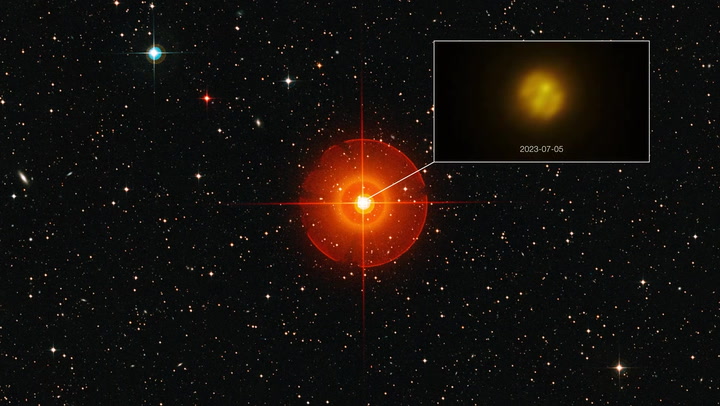Scientists Observe Surface Bubbles on a Star
For the first time ever, astronomers also filmed a star which is not the Sun and observed the motion of gas bubbles on the star’s surface. The obtained images of the star R Doradus taken by ALMA telescope in July – August 2023 reveal the formation and the fast sinking into the star’s body of the hot, massive gas bubbles 75 times larger than the Sun.
”This is the first time one could see the surface of the star as it is bubbly,” says Wouter Vlemmings and he is a professor of Chalmers University of Technology specializing in Sweden. “We never expected that the data would be so good that we could begin to see such fine structure of convection at the surface of stars. ”
Stars produce energy by nuclear fusion in the centers which rising to the stellar surface in huge, and hot gas bubbles. These bubbles cool down, fall back down, a type of heat transfer called convection because it looks like a lava lamp. Because the material in these ‘ices’ is extremely thin it counteracts and collapses under gravity’s pressure helping to distribute heavy elements such as carbon and nitrogen and is believed to cause stellar winds that carries these elements into space, eventually helping in the formation of new stars and planets.
Until now, only the Sun had been captured with such a rich degree of convection tracking. In particular, the team was able to use ALMA to gather high-resolution images of R Doradus’s surface for a month. R Doradus, a red giant star which is approximately 350 times larger in diameter compared to the Sun is in the constellation Dorado and it is roughly about 180 light years from Earth. Its closeness makes it a good target for closer observation and its size is comparable to that of the sun, hence it can give us a clue of the appearance of the sun when it will become a red giant in five billion years’ time.
’Convection produces the granular structure observed on the Sun’s disk, while it was difficult to detect similar features on other stars,’ explains Theo Khouri, a Chalmers researcher and one of the authors of the study. “With ALMA we can see and measure these convective granules which are 75 times the size of our sun for the first time. ”
It is clear that the granules present on R Doradus take a cycle of one month which is far from the cycle relative to solar convection. ‘The reason for this remains unknown,’ convection, it appears, evolves with age in a way that is still unclear, says W Vlemmings. Indeed, observations of R Doradus are contributing to the understanding of what happens to stars like the Sun at this phase and at the same time turns into large, cool and hence energetic red giants.
’It is quite amazing that we can now point the telescope straight at the star and observe some physical phenomena that was possible to observe only in our Sun,’ says Behzad Bojnodi Arbab a Ph. D. student at Chalmers and an author of the paper.
Summary
Astronomers have captured detailed images of a star beyond our Sun, allowing them to track the movement of bubbling gas on its surface. The images of R Doradus, taken in July and August 2023, reveal enormous, hot gas bubbles—75 times larger than the Sun—emerging on the surface and rapidly sinking back into the star’s interior, more quickly than anticipated.
Do not forget to share your opinion with us to provide you with the best posts !




0 Comments